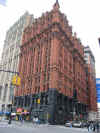 |
New York
Architecture Images-Seaport and Civic Center Potter Building Landmark |
|
architect |
Norris G. Starkweather |
|
location |
38 Park Row |
|
date |
1886 |
|
style |
Beaux-Arts |
|
construction |
iron-framed, brick building. Cast and pressed terracotta, first use of terracotta fire-protected steel frame. |
|
type |
Office Building |
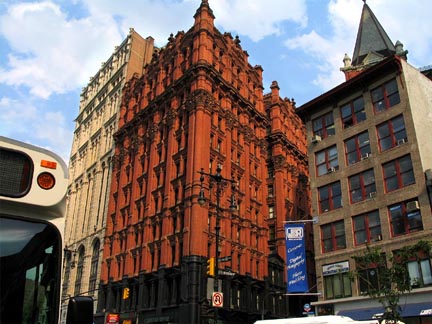 |
|
 |
|
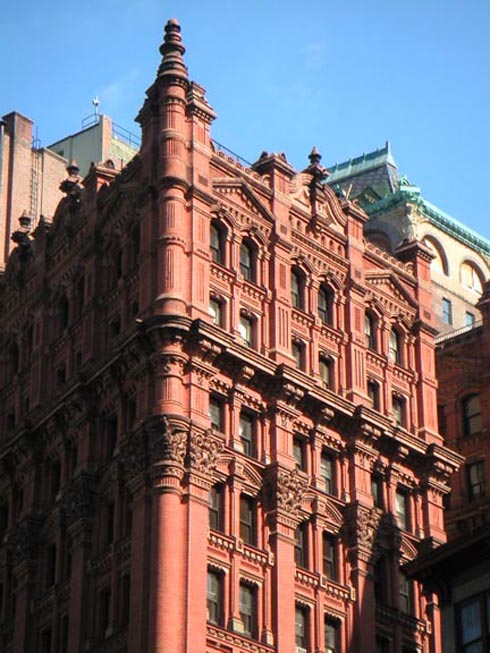 |
|
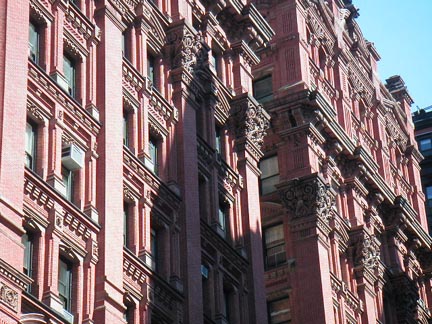 |
|
 |
|
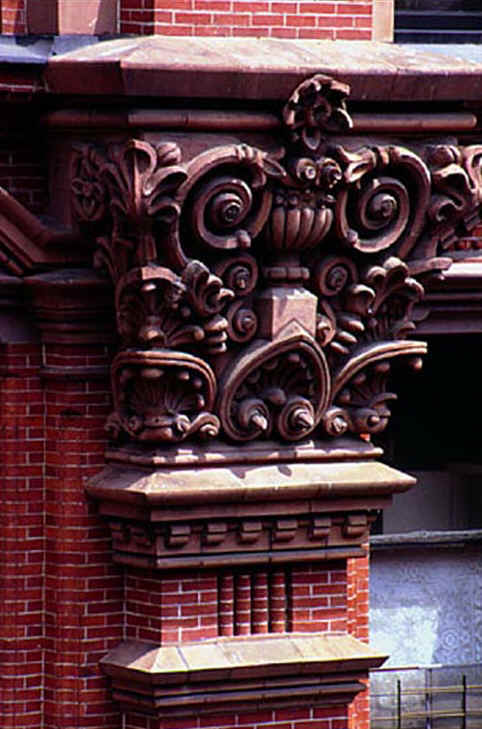 |
|
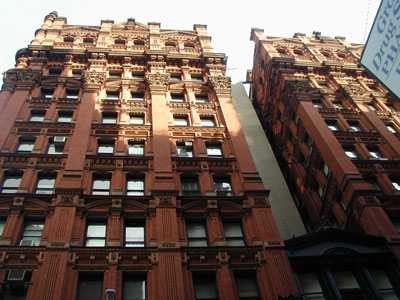 |
|
| This iron-framed, brick building is a riot of robust clay capitals and classical details. What was viewed as its greatest innovation at the time of its completion was its virtually fireproof construction, a strength advertised by its iron-clad lower stories and storefronts. The richly ornamented façade is anchored by dramatic eight-story vertical piers in brick with enormous terra-cotta capitals, and the colossal eleven-story embedded column that seem to hinge the corner of Nassau Street and Beekman Place. A builder's plate giving the name of the foundry responsible for the cast iron work remains at the building's southwest corner. The Potter Building is a masterpiece of architectural terra-cotta, and its construction played an important role in the development of terra cotta as a building material in New York. Terra cotta, a type of clay that is molded and fired, was chosen by the building’s owner, Orlando Potter, for its fire resistant properties and low price. At the time, no source of terra cotta existed in New York, and a Boston company was hired to provide the material. Soon after the building’s completion, Potter founded the New York Architectural Terra-Cotta Company, which would manufacture much of the terra-cotta ornament widely used in later skyscrapers. | |
|
notes |
The massive Victorian skyscrapers on Park Row were built by the city's nineteenth-century newspaper publishers, who found it advantageous to maintain proximity to City Hall and the financial district. From left to right are: the Pulitzer Building (G. B. Post, 1890); the Tribune Building (R. M. Hunt, 1876); the Times Building (G. B. Post, 1889); and the Potter Building (1883). At the turn of the century, the papers began to move uptown, leaving only the name "newspaper row" as their legacy. Abbott's photograph of City Hall Park and Park Row, which was taken from the 14-story Postal Telegraph Cable Building at 253 Broadway, was one of her least dynamic compositions, resembling a postcard view. She rejected from the project her equally mundane view of City Hall, a building she wanted to include for its historic importance but did not like architecturally (McQuaid, 343). Today, half of "newspaper row" has been demolished: the Pulitzer Building gave way to the Brooklyn Bridge's entrance ramps in 1955, and the Tribune Building was razed for Pace University's massive tower in 1966. OLD POTTER BUILDING FIRE IN MANHATTAN January 31, 1882 JOHN J. HORAN, AND JAMES E. NOLAN
Privates, Hook and ladder Co. No. 10
At the Potter Building Fire, on the thirty-first of January, 1881,
especially distinguished themselves. Rooney, standing on a ladder raised
five feet from Beekman Street, saved Miss Ida Small. Murray and Horan saved
Alexander Roberts with a ladder resting on the sill of a third story window.
Two men were caught as they dropped from a signboard on the fourth story by
Nolan, who was on the top of a ladder, and Schwab joined in peril and
piloted to the street five men.
POTTER BUILDING FIRE 1882
January 31st, 1882, at 10:12 P. M. a destructive and fatal fire broke out in
the Potter or World Building, which faced On park Row, Beekman Street and
Nassau Street. It did more than $400,000 damage, and twelve persons were in
various ways killed. The fire directed attention to a source of peril to
life and property which had before created apprehension, and on the 3d of
February Commissioner Purroy offered the following resolution, which was
adopted:
Whereas, there have recently been constructed in this city a great number of
large flats and business houses, reaching in many cases to a height
exceeding one hundred feet; and whereas the extreme height to which it is
possible to stretch and mange extension ladders have been probably reached,
and does not exceed seventy feet, thus making futile the vest efforts of
this Department toward rescuing the occupants of the upper stories of the
buildings above mentioned whenever such occupants are cut off from escape
from below; there fore be it
Resolved, That the chief of Department be and is hereby instructed (keeping
in view the increased height of the buildings above mentioned) to report to
this board in writing his views in regard to what improvements in the
appliances and complements of the Department, what changes in regard to the
erection and construction of fire-escapes, and what regulation as to the
construction and maintenance of fire-proof shutters are necessary, together
with any suggestions in regard to the better protection of life and property
he may deem advisable.
Chief Bates' report favored the providing of each Hook and Ladder company
with scaling ladders, one of fifteen feet and one of twenty feet, and a
life-line, and the principal companies were thus equipped. Commissioner
Purroy's foresight was displayed in the resolution which resulted in the
"doubling up" of the most important companies.
|
|
links |